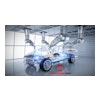The NTSB last Thursday came out with a report detailing lithium-ion batteries, as well as other possible ignition sources, that can create a fire safety risk while scrap materials are being transported.
Scrap metal cargo is typically deemed non hazardous, but the fires are piling up. For example, on May 23, 2022, the Daisy Mae was towing a scrap metal barge north in the Delaware Bay when a fire broke out on board. The fire burned for some 26 hours before fire boats could put it out, to the extent that molten metal was photographed leaking out of the ship.
The barge was transporting more than 7,050 tons of scrap metal called “shredder feed,” a lower grade ferrous scrap metal that consists of a variety of different metal scraps, like old, crushed vehicles and household appliances.
While no one was injured in the fire and the ship was okay, the damage to the barge alone reached $7 million. The investigation also reported no pollution, but molten metal was seen leaking off the ship.
The Daisy Mae wasn’t an anomaly, but rather a part of a growing concern. In 2022, nearly 400 waste and recycling facility fires were reported in the U.S. and Canada, that is the highest number since Fire Rover, a fire suppression company, started tracking reports in 2016.
A pair of international vessels experienced blazes in 2022 and 2017 that were chalked up to fires in the cargo hold. And, in January last year, a pile of scrap caught fire on a New Jersey shore.
According to the NTSB, these fires could be caused by a number of issues. The ignition source seems straightforward, a bunch of metal cargo is piled on top of each other, it shifts and ignites something combustible, like improperly prepared vehicles that haven’t been properly drained of fluids or damaged lithium-ion batteries.
Even if suppliers are doing their best to clean up the scrap metal and quality assurance personnel are visually inspecting it, metallic and nonmetallic hazardous materials are often still found in these piles, and these often-flammable materials could lead to intense fires aboard cargo ships.
The NTSB says these scrap metal piles need to be cleaned up and better inspected before they are loaded onto vessels, because, once scrap metal is loaded onto a barge, it is difficult for the crew to inspect the cargo.
Qualified cargo-surveying personnel can help limit hazardous combustible material, by watching it as it’s loaded onto the vessel. The NTSB also recommends using thermal imagery to identify hot spots in scrap metal cargo at shoreside facilities.






















